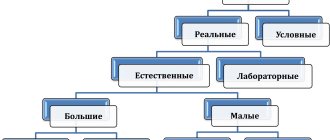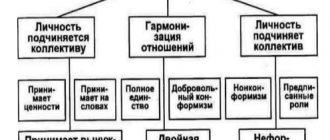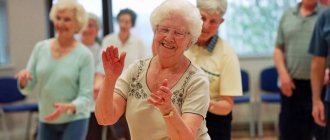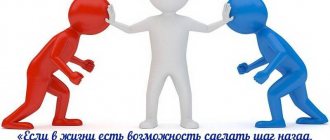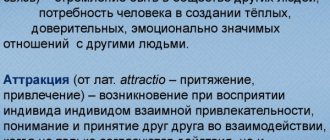The concept of group is one of the key categories of psychology. Acting as a necessary social environment, an integral condition for the development and formation of personality, one of its leading needs, the group largely determines the characteristics of personal development.
In the process of socialization and life activity, a person is constantly included in various social groups, occupying a certain social position in each of them, realizing certain social roles. In the process of interaction with a team, a person can be absorbed by the group, however, most often, belonging to a team covers only some personality traits, influencing the person, but not subordinating him.
The concept of a group in psychology: the role of the group in personality development
Belonging to a group is a basic need necessary for the normal development of social skills. Rejection or inability to join a community of people leads to the degradation of the individual and reduces his emotional and intellectual skills. But at the same time, too much influence from the group suppresses the development of individuality. Therefore, an important condition for mental health is maintaining a balance of personal-group interaction.
At the same time, an individual belongs to several groups: professional, social, family, friendly, ideological and others. His position in groups may vary, depending on the degree of involvement, compliance with the expected role, and personal interest.
A group is a relatively stable formation whose members are bound by norms, values and goals.
It necessarily has its own rituals, forms of joint activity, code of conduct, forms of encouragement and sanctions. Groups can be identified by the following criteria:
- Integral psychological characteristics. These include features that are formed in the process of development of the team: attitudes, norms, climate, interests. The regulation of the behavior of individuals within a group is carried out by the social phenomenon of interaction: the collective directs the behavior of the individual, and the community of individuals adjusts behavioral norms.
- Structure and unity. A chaotic formation becomes unified when it develops structure and norms. Group composition includes the main indicators: number, composition, positions of individual team members. Each individual within the community performs a specific function, observing formal norms of behavior. Also, informal relationships may be established between individuals, caused by personal sympathy or antipathy.
- A sense of belonging. A group emerges only when its members recognize themselves as part of a community. At the same time, they may experience different emotions: from joy and inspiration to disappointment and desire to leave the group. What is important is not the emotional personal assessment, but the sense of belonging itself. To instill this feeling, the group uses internal mechanisms of influence, such as pressure. It forces a person to adjust behavior in accordance with accepted norms.
- Consistency of actions. The need to act together is dictated by the need to maintain group status and achieve a goal.
- Establishing relationships. Relations between individuals develop in parallel with the development of the community itself and the distribution of roles.
The more developed the sense of cohesion, the greater the chance of the association to occupy a socially significant position and influence other communities, gradually strengthening its positions and popularizing its views.
The structure of the group as a psychological category
Definition 1
The category of group in modern scientific literature is understood as a relatively stable set of individuals connected by a complex system of relationships that are regulated by group values and norms.
Are you an expert in this subject area? We invite you to become the author of the Directory Working Conditions
The obligatory structural components of a group as a psychological phenomenon are the presence of common goals, norms, a system of sanctions, group rituals, a material, objective environment, and joint activities.
Classification of associations by composition, features, forms of relations
Groups are divided into conditional (identified by researchers based on a common characteristic) and real (existing as a community). Real groups are divided by the nature and characteristics of interaction
- Nominal - organized spontaneously, exists temporarily. Members of the community do not develop close relationships; their main interest is performing certain activities. Such communities include tourists, spectators, and public transport passengers.
- Association is a union that includes only individuals united by common goals (union of friends). As a rule, they are stable, leadership is democratic in nature.
- Cooperation is a stable community with clear goals. The level of cooperation is high, the relationship is businesslike, and the hierarchy is strictly observed. Thanks to this, high performance in the chosen type of activity is achieved.
- Corporation - unites around internal goals, ignoring external ones. Acts as an asocial association, not inclined to cooperate with other communities.
As a rule, the format of group relations is determined before the formal unification of the community. But accidentally entering a community with a strong leader with interests that contradict the original ones can change the internal foundations and direction of the community.
Group sizes: features of interaction between individuals depending on quantitative characteristics
Modern group psychology distinguishes 3 types of communities based on the number of people:
- Big - a large association, the relations within which are formal, but not stable. Belonging to such associations provides socially significant attitudes, rights and responsibilities. Large groups include the state, professional associations, and religious communities.
- Small is the main form of the collective, determining the individual’s opinion about himself and his place in society. A small community creates a standard of thinking and behavior that a person strives to conform to.
- Microgroup - consists of 2-3 individuals. It has all the characteristics of a group; the nature of relations between members is informal, based on trust, respect, and mutual sympathy.
As individual qualities develop, a person may move from one group to another or try to change the characteristics of the association in which he initially found himself.
Groups and their classification
Brest State University named after. A.S. Pushkin
Essay
GROUPS AND THEIR CLASSIFICATION
Brest 2010
The founders of scientific communism revealed the social essence of man. “The individual,” wrote K. Marx, “is a social being.” The social essence of a person is manifested in his material and spiritual life. Isolated from other people, he could not turn from a slave of nature into its master.
The historical conditions of life and communication led to the fact that people united into nations, states, classes, parties and other communities. They were formed not at will, but by virtue of objective laws. Each community is characterized by certain psychological characteristics. Marxism highlights, first of all, the specific features of the psychology of various classes, which V.I. Lenin defines them as “large groups of people, differing ... in their attitude (mostly enshrined and formalized in laws) to the means of production, in their role in the social organization of labor, and, consequently, in the methods of obtaining and the size of the share of social wealth that they have . Classes are groups of people from which one can appropriate the work of another, due to the difference in their place in a certain structure of the social economy.”
Throughout life, a person directly communicates with other people, realizing his social essence. This communication takes place in groups and teams. These communities are heterogeneous. They can be classified on several grounds: proximity to the depth of the developing relationships, the principle of formation, the individual’s attitude to the norms of the group, etc. Therefore, we can give the following definition to the concept of group.
A group is a community of people limited in size, separated from the social whole on the basis of certain characteristics (the nature of the activity performed, structure, level of development, etc.). Everyone who is part of it knows each other personally and communicates with each other in the process of solving the problem facing the group. Also, everyone can communicate as desired and necessary. In practice, group members give preference to one over the other. They communicate more often, contacts are close (on a personal or business basis).
Now consider one of the most common classifications of groups (Fig. 1)
Rice. 1. Classification of groups
To size
Large group (conditional) – a quantitatively unlimited conditional community of people, distinguished on the basis of certain social characteristics (gender, age, nationality, etc.)
Large group (real) - a large and complexly organized community of people involved in one or another social activity (for example, a university team, an enterprise, etc.)
Small group – (from two to several dozen people) a relatively small number of directly contacting individuals united by common goals and objectives.
By social status
Formal (official) - a real or conditionally social community that has a legally fixed status, the members of which, under the conditions of the social division of labor, are united by socially assigned activities, organizing their labor.
Formal groups always have a certain normative structure, appointed or elected leadership, normative rights and responsibilities of its members. For example, student group, teachers and school staff, etc. Business contacts are established between group members. They imply subordination or equality. The official group can be restructured, but this is again done on the basis of a specific decision. Relationships in official groups, even with the same instructions, cannot be identical, since people with unique character traits, temperament, abilities, and communication styles come into contact.
An informal (unofficial) group is a real social community that does not have a legally fixed status, voluntarily united on the basis of interests, friendship and sympathy.
Informal groups can act as isolated communities or develop within formal IDD groups. For example, groups of playmates, companies of fishermen, hunters, etc. are formed. Sympathies and affections cement the group. If they disappear, then the group certainly disappears.
According to the directness of relationships
Conditional group – united according to a certain characteristic (nature of activity, gender, age, etc.). For example, sports journalists decide to form a team of the best football players in the world. They select stars of the first magnitude and combine them into a list. The players will never come together and the team will never compete. But it is composed and exists conditionally.
A real group is an association where people are connected by real contacts, i.e. the relationships of its members, common goals and objectives (for example, a group of classmates). A real group can exist for a short time or a long time, be numerically large or small. It exists and functions as a community.
According to personal significance
A reference group is a real or conditional social community with which an individual relates himself to the standard and to the norms, opinions, values and assessments of which he is guided in his behavior and self-esteem.
A person formalizes his assessments, views, finds role models that he values and follows. For example, a teenager strives to be a member of a group of older schoolchildren or adults. If he fails to do this, then he imitates the norms of behavior that exist among his elders.
A non-reference group is a group whose psychology and behavior are alien or indifferent to a person.
An anti-reference group is a group, the behavior and psychology of whose members a person does not accept, condemns and rejects.
By level of development
Low level
A diffuse group is a community in which there is no cohesion as a value-oriented unity, there is no joint activity capable of mediating the attitude of its participants.
An association is a group in which there is no joint activity, organization and management that unites it, and value orientations that mediate interpersonal relationships manifest themselves in group communication.
Depending on the social orientation of the mediating factors, prosocial associations and asocial associations are distinguished.
Prosocial associations are groups into which positive moral values were brought from the wider social environment, formed and strengthened in the process of work. If these associations are included in joint activities determined by socially significant tasks and the corresponding organization and leadership, they go through the path of collective formation. For example, a student group at the beginning of the educational process.
Asocial associations are groups with value orientations that are negative, sometimes antisocial. For example, a group of aggressive teenagers. These groups, under conditions of antisocial organization and leadership, easily turn into asocial corporations.
A prosocial corporation is an organized group characterized by isolation and maximum centralization. For example, industrial corporations.
An asocial (antisocial) corporation is a group that opposes itself to other social communities on the basis of its narrowly individualistic interests. Interpersonal relationships in corporations are mediated by asocial and often antisocial value orientations. For example, a well-organized group of racketeers or the mafia.
High level
A team is a group of people united by common goals and objectives, which has achieved a high level of development in the process of joint activities. A special type of interpersonal relationships is formed in a team, characterized by high cohesion such as value-orientation unity, collectivistic identification, etc. (Fig.2)
Rice. 2. Main features of a mature team
The problem of the group as the most important form of social unification of people in the process of joint activity and communication is one of the central problems in psychology. The group, as an independent subject of activity, can be considered from the point of view of its properties, processes and structures.
The main parameters with the help of which a socio-psychological analysis of a group is possible are the characteristics of the group itself and the characteristics that determine a person’s position in the group. Characteristics of a group include its composition, structure and group processes. The characteristics that define a person in a group include the system of group expectations, statuses and roles of group members.
The composition of a group, or its composition, is a set of characteristics of group members that are important from the point of view of analyzing the group as a whole. For example, the size of the group, its age or gender composition, nationality, etc.
The structure of a group is considered from the point of view of the functions that its individual members perform, as well as from the point of view of interpersonal relationships in it.
The concept of a group can be viewed from different points of view.
Bourgeois group theories
Bourgeois theories of groups are characterized by the heterogeneity of their initial positions, but they are united by one thing - the desire to replace the socio-economic, ideological and class relations of bourgeois society with professional, socio-psychological, and psychological ones.
Many representatives of these theories consider social organization and psychological group to be the basic units of society. Social organization meets the criteria: formalized relationships and the existence of a hierarchy of power.
A psychological group is characterized by the following indicators: a) interchangeability between group members, b) commonality of views, beliefs, norms, c) commonality of purpose.
Depending on the understanding of the relationship between the individual and the group, two directions have emerged in bourgeois social psychology: structuralists and personalists. The first believe that in the “organization - individual” system, i.e. in relation to the group and its member, the organization and structure are of key importance. It must create optimal conditions for the full use of human resources. If a person works poorly, then the reason is the imperfection of the group structure, methods of control, and the exercise of power in it. At the same time, it was initially believed that the best structure was a formal group, and then the idea was put forward about the advantage of an informal organization.
Personalists come from different attitudes. The main thesis of the personalists: the structure of the group (formal and informal) does not matter. A person's level of effectiveness depends on his abilities, how he evaluates them, and the extent to which he possesses them.
These concepts do not go beyond the framework of bourgeois ideology. They are called upon to find ways to strengthen the capitalist system of labor organization, increase productivity, and ensure super profits. Both directions in their theoretical and practical conclusions preach profit and pragmatism.
Group Study Methods
The main method of studying groups is observation. It makes it possible to find out the meaningful side of the life of communities, their structure, level of development, etc. Social psychology distinguishes between included and non-participated observation. The first presupposes the entry of an observer or researcher into the community as a member. In this case, he seems to be studying the group from the inside. He not only explores, but also participates in all matters. Non-participant observation is the study of a community from the outside, without direct participation in its life. The teacher, due to the specifics of his work and the uniqueness of his position in relation to the children's group (class, pioneer detachment, Komsomol group), finds himself in the position of both an included and a non-involved observer. In some cases he becomes a member of the group, in others he remains outside the children's community.
A natural experiment is used to study some aspects of group life. It is carried out under normal conditions for the subjects, the content of the experiment corresponds to the activities of the given community. For example, in a class group, debate is practiced as a form of extracurricular educational work. But a debate can be experimental if it solves research problems and is carried out based on these problems. A trip outside the city can also be experimental if some research problems are solved during it.
A fruitful way to study groups is to conduct a survey to identify the opinions of group members about various aspects of the life of a given community. For example, a survey is carried out in the classroom about the content and standards of extracurricular work, the opinion of schoolchildren about the state of their studies is revealed, etc. The survey has several varieties. The most commonly used are interviews and questionnaires. An interview involves obtaining information from a person through direct communication; questionnaire - an answer to questions recorded in writing, which creates the condition for familiarizing yourself with the entire questionnaire and thinking through the answer to each question. The interview and questionnaire may include open and closed questions. For closed questions, answer options are included in the questionnaire. For example: “Is your pioneer detachment working well?” Answer options: “Yes”; "No"; "Don't know". For open questions, a detailed answer is expected. For example: “What attracts you to the work of the pioneer detachment?”
Thus, the group is an extremely complex organism, whose activity unfolds simultaneously in many directions and requires special efforts, combining individual activities into a single whole.
Literature
1. General psychology Edited by: V.V. Bogoslovsky, A.G. Kovaleva, A.A Stepanova
2. General psychology Edited by Academician of the Academy of Pedagogical Sciences of the USSR A.V. Petrovsky
3. Psychology A.V. Petrovsky
Information about the work “Groups and their classification”
Section: Psychology Number of characters with spaces: 13617 Number of tables: 0 Number of images: 2
Similar works
Small group - concept and classification
32896
0
0
... Classification of small groups The abundance of small groups in society implies their enormous diversity, and therefore their classification is necessary for research purposes. The ambiguity of the concept of a small group has also given rise to the ambiguity of the proposed classifications. In principle, a variety of bases for classifying small groups are acceptable: groups differ in the time of their existence (long-term and ...
Budget classification and its reform
50900
5
0
... accounting, which significantly increased the transparency and managerial significance of budget reporting. During this period, reform of the budget process was carried out in the following areas: reform of budget classification and budget accounting; allocation of the budget for “current” and “accepted” obligations; improving medium-term financial planning; development and expansion of the sphere...
Classification of goods (using the example of shoes)
20026
0
0
...at the same level they must exclude each other. Classification must be continuous and consistent. There are educational, industry, state and international classifications of goods. Educational classifications are used in commodity science for the purpose of the most convenient, logical and systematic study of the range of goods. Industry classifications are developed and applied in various...
On the issue of classification of Turkic languages and dialects
57073
0
0
… . Before talking about how areal linguistics can, to a certain extent, resolve the problem of language type, it is necessary to consider the basis of the existing classifications of Turkic languages. V. A. Bogoroditsky divides all Turkic languages into seven groups: 1) northeastern, 2) Khakass (Abakan), 3) Altai, 4) West Siberian, 5) Volga-Urals, 6) Central Asian, ...
The process of group formation: stages of development and distribution of roles
The formation of a community occurs in 3 stages:
- Formation and initial unity. Individuals get acquainted, primary recognition of each other occurs. There is a high level of emotional tension, which disappears as acquaintance deepens. Group members learn rules of behavior and form a sense of belonging. At this stage, one or more leaders are identified.
- The emergence of contradictions and conflicts. There is a conflict of interests between small unions and individualists trying to assert their place in the team. The struggle for leadership leads to contradictions, quarrels and division.
- Constructive cooperation. The level of psychological unity increases. The group acquires status in society and approaches the status of a collective. The emotional atmosphere levels out and becomes friendly.
The process of an individual’s entry into a team occurs in 3 phases:
- Adaptation. The personality learns the rules of behavior, and is still constrained in the manifestations of individual qualities.
- Personalization. The personality declares itself in order to take the most advantageous place in the hierarchy.
- Integration. The team determines the newcomer’s place by assessing his personal qualities.
The following roles are distinguished in the group according to the level of authority:
- leader;
- popular;
- preferred;
- ignored;
- outsiders.
The higher the status of an individual, the more power he enjoys. In the process of development of a team, individuals can challenge the assigned status, moving to the top level of the hierarchy. If the rules of behavior in the group are neglected, the individual who initially occupied a high position may move down.
The predominance of public interest over personal interest: the formation of a team
The team is a group with a high level of development. To achieve this stage of community, it is necessary to act consciously and follow the plan, obey the requirements of the leader.
The team is characterized by:
- unity of motives and goals aimed at mutual assistance and support;
- conditions for personal development;
- group nature of the activity;
- voluntary and positive interaction;
- joint development of ways to achieve the goal.
To become a collective, a community must go through the following stages of development:
- The moment of occurrence.
- Naming.
- Emotional integration.
- Unity of purpose.
- Integration of goals into general social ones.
At the last stage, the interests of individuals become focused on a global goal and move to the stage of a pseudo-collective, for which personal goals are more important than public ones.
Productive communication within a team occurs due to the process of perceiving a person by a person - the formation of an image that arises during direct communication.
Perceptual mechanisms that enable interpersonal communication include:
- Identification is likeness to another individual, a primitive form of attachment. The object of identification can be either a real person or a fictional character.
- Empathy is penetration into a person’s emotional state, sharing his feelings.
- Reflection is an assessment of one’s own mental state, analysis of the impression made on team members.
- Attraction is the formation of attachment based on the attractiveness of one individual to another.
In a developed team, an individual works for public interests, but gets the opportunity to develop his strengths. The team works as a well-coordinated team, directing its main aspirations towards universal human interests.
Collective opinion
An example of information pressure is the “Thumbelina” situation. One cocktail thought Thumbelina was very beautiful until another cocktail told him she was ugly. With this information, the cockshafer community forced one of them to abandon his allegiance in favor of the majority. Stimulating conformity is expressed in the fact that the group offers individual protection from discomfort outside the group, in turn, the person tends to exaggerate the value of the group and adhere to group norms and corporate ethics. The group values and supports especially those who have high intellectual potential and willpower, who consciously contribute to the development of the group, increase its authority and influence. Sometimes peer pressure forces one to resort to feigned conformity as a psychological defense - the motive is to gain acceptance in the group or to stay out of trouble. Nonconformism as consciousness and behavior leads to isolation.
Collective opinion is a psychological phenomenon that truly shows the existence of a “we-feeling” and conformist majority in a group. This is clearly visible in group decision making. Typically, a group takes the average of individual decisions, and group decisions are riskier than individual decisions. For example, a group as a whole easily decides not to attend a lecture, while an individual student does not take it upon himself to interrupt classes. In the solution search phase, individual solutions are more productive, while in the development or testing phase, group solutions benefit.
The group's decisions reinforce initial opinions, i.e. a person who is convinced that money should be distributed equally will strengthen his decision as a result of group discussion, as will a person who proposed an employment quota. The weakness of group decision making is that it is dominated by the search for consensus, i.e. personal opinions coexist with the group decision, weakening its strength and cohesive force. At the same time, group decision-making creates the illusion of group strength and cohesion, the invulnerability and ethics of the group are postulated, and the stereotypical image of the opponent prevails.
Therefore, we looked at the basic psychological phenomena that occur when people come together to form a group. Now let's move on to the analysis of the psychological components accompanying the functioning of the group.
The group goes through certain stages of development: the stage of acquaintance, the stage of aggression, the stage of stable performance, the stage of disintegration. Group dynamics is the process by which interaction between individuals reduces each individual's stress in a given situation and leads to mutual satisfaction and desire to be in a group. Or vice versa, an increase in tension, conflict and a decrease or cessation of interaction, loss of “we-feeling”, disintegration of the group.
The first stage is “Getting to know you.”
Confirmation by group members that they have common interests, demonstrating willingness to work in a group. True goals vary, but people come together as a group to achieve a common goal or so that everyone can achieve their own.
I'm joining the group. In the group, my personal image is formed, communication skills are practiced, values, norms and rules of behavior are learned. What will this group give me? What do people look for and value in a group or organization, what is their motivation for joining THIS group?
The person loves independence. In a REAL group you rise higher, become freer, or a REAL group promotes: professional growth, increased responsibility, development of creative abilities, satisfaction of the need for competition, maintaining or increasing the level, method, way of life. The system of rewards and punishments, the information system, the professional development system, the attractiveness of work, emotional satisfaction from mutual communication - all these are components of a person’s business life that cannot be identified outside a certain group.
How should I behave? In order for my existence in a group to be psychologically comfortable, I must enjoy the favor and respect of the majority of group members. I can: Option 1 - gradually win the favor of each member of the group, relying on my charm; Option 2 - immediately demonstrate your superiority of intelligence and beauty. Professional skills, physical strength, in that I am stronger than others; Option 3 - don’t stand out, be a conformist in the group; Option 4 - stand out, behave demonstratively “not like everyone else”, attract attention with your originality; Option 5 - follow the behavioral style of the “White Crow”. That is, avoid participation in group activities and maintain a minimum level of loyalty. Remain a member of the group. At the stage of acquaintance in a group, a person introduces himself in the group as an individual, checks whether his motivation for joining the group corresponds to real circumstances, and chooses a style of behavior in the group that corresponds to his character and worldview.
The second stage is aggression.
This scene has a somewhat symbolic title. She emphasizes that grouping does not level, but reveals human individuality. After the ritual of familiarization and understanding of the general rules of functioning of the group in the social system, the distribution of socio-psychological roles within the group begins. Group members place and set role expectations for themselves and others. One person pretends to be a leader, another - a critic, a third - “the first beauty”. There are “tournament battles” - in cases where a niche cannot support two people, or when rivals have mutual hostility. For example, two applicants for the role of leader can: lead in pairs, lead their role, reject one or both, fight. Of course, group “fights” are not like those of male deer or baboons. Arguments and discussions take place in the group; at best, the desired “place” is occupied by a silent victory, expressed in the form of public approval - everyone consults with M., so he is recognized as the smartest; or everyone professes K., so she is the emotional center of the group. Sometimes formal elections are possible: headman, manager, president of the company. In the worst case, intrigues begin to swirl, gossip spreads, groups of followers are formed, and they turn to their superiors. In any case, the result is that the group forms its own structure and rules of operation.
Level 3 - Sustained performance.
The psychological effectiveness of a group depends on the harmony of its internal socio-psychological structure. Group cohesion is the process of transition of an external structure into a psychological community of the “we” type. For each group member, commonality is determined: Satisfaction with one’s position in the group, emotional attractiveness of group members, similarity of interests, preferred type of interaction within the group - competition or cooperation. For example, a professor who is an associate professor, to whom the department grants the right to give lectures, a respected person who has colleagues as friends - he feels comfortable, and his consciousness and behavior are determined by the concept of “our department.” Of course, most members of a formal group with this kind of thinking and behavior tend to develop into a team with very high levels of performance.
Conflicts within the team, means of intragroup influence
Conflict is an inevitable social phenomenon, which is necessarily included in the concept of a group in psychology. In psychology, conflict is a relationship between subjects characterized by confrontation of ideals, goals and interests. Conflict can be intrapersonal, interpersonal and intragroup. The more individuals are involved in the confrontation, the more destructive and larger-scale the impact of the situation on the development of the team.
Stages of conflict development in a team:
- Pre-conflict - the subject of the conflict is highlighted, there are no clashes between opponents yet. Dissatisfaction and emotional tension increases.
- An incident is an open clash that is the impetus for the development of a conflict.
- Escalation is the upper limit of conflict development. The parties to the conflict perceive each other as enemies, and the argument moves to the level of personal insults and claims. At this stage, the need to resolve the conflict becomes obvious to all participants.
- De-escalation is the end of a conflict, the transition from resistance to the search for a joint solution.
The means of intragroup influence used by the leader or influential members of the team can prevent the emergence of conflicts. These include:
- infection - voluntary or involuntary transfer of one’s condition to other individuals;
- persuasion - influencing opponents in order to instill in them your point of view;
- suggestion - influencing a person through the power of authority, changing opinions with the help of rituals, peculiarities of speech;
- coercion - the use of open or hidden threats, the demand to comply with the leader’s orders;
- request - a benevolent non-violent call to fulfill the wishes of the requester;
- criticism - the use of a negative assessment of an individual’s personality or actions, insult and neglect;
- ignoring is a special careless attitude that causes emotional instability.
A special means of influence is manipulation. The use of manipulative influence allows a group member, without being a formal leader, to influence interpersonal interaction, the formation of goals and methods of achieving them.
